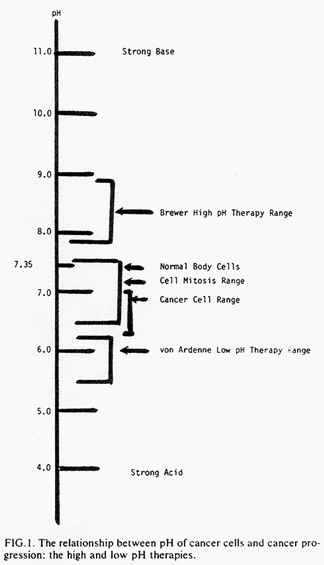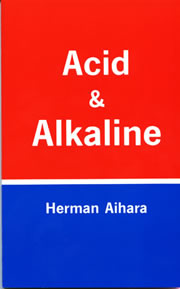pH Balancing Regimen
 Summary: The best way to ensure a good balance for most
people is to just eat two servings or more of fruit or vegetables for every
serving of protein or grain and use a multimineral.
Summary: The best way to ensure a good balance for most
people is to just eat two servings or more of fruit or vegetables for every
serving of protein or grain and use a multimineral.
Some think cancer and some other degenerative diseases are affected by a too-acid mantle, so raising pH to normal levels is desirable. Oxygen is absorbed more efficiently by the cells when the body is tending alkaline. Alkylosis can be a problem just like acidosis, although it is less common. One problem with tending toward acidosis is that the body will maintain blood pH in a narrow range at all costs.
Base minerals (calcium, magnesium, potassium, sodium) balance out acid minerals (sulfur, phosphorous, chlorine). Balance is best - don't try to overcompensate by eating only base fruits and vegetables since phosphorous and sulfur are important to the body, too.
When the body tends acid, calcium and other minerals are removed from the bones or organs to bring the pH up, and this can cause mineral deficiencies which can affect cellular respiration and nutrition, immune function, and contribute to mineral deposit formation. When it is too base, the kidneys merely excrete the extra minerals, which is no problem (unless there is renal insufficiency.) This is one reason acidosis is much more common than alkylosis. The other reason is most people do not eat enough fruit and vegetables to compensate for all the grains and meats they consume.
The way to tell toward what one tends is to use nitrazine paper for a few mornings and see what the average pH is. It is usually used for urine, but will work with saliva, too. The ideal pH is around 6.0-6.5 for morning urine. Nitrazine is pH paper that gives an indication of the actual pH rather than litmus paper, which only tells greater or less than 7.0. It is expensive, and available at some pharmacies - call around.
If the urine is too acid, the easiest solution is to use a mineral supplement, especially at night. A product like Ecological Formula's Tri
Salts, which is reagent quality calcium, magnesium, and potassium carbonates and bicarbonates, works faster than almost every type of supplement. However, it is not the ideal method. These types of mineral supplements are not well absorbed by the body and most of the minerals are immediately delivered to the bowel or kidneys for disposal, which does make an immediate difference in the pH of the urine, but since it was not absorbed into the bloodstream, it did not really do the body much good. These types of minerals may even be deleterious to the urinary tract since acid urine fights bacteria, yeast, and other pathogens not to mention the extra duty on the kidneys processing the minerals. It is better to use well-absorbed forms. Good products include Solaray Cal-Mag Citrate, a 1:1 ratio calcium magnesium type, Enzymatic Therapy Kreb's Cycle Chelates, Now Bone Strength, or Jarrow Mineral Balance, but most other chelated products are fine for this purpose. See the multimineral section for more information and detail on these types of products.
 As far as adjusting the body pH up through dietary means, the best solution is to eat more fruits and vegetables and less grains and meats. The pH tendency of foods is not much based on their acid content or taste, but on the mineral content. For example, lemons make the body alkyline and most bread makes it acid.
Tomatoes are problems for some people not as much for the acid or mineral
content as the lectins. SeeEat Right 4 Your
Type
As far as adjusting the body pH up through dietary means, the best solution is to eat more fruits and vegetables and less grains and meats. The pH tendency of foods is not much based on their acid content or taste, but on the mineral content. For example, lemons make the body alkyline and most bread makes it acid.
Tomatoes are problems for some people not as much for the acid or mineral
content as the lectins. SeeEat Right 4 Your
Type
Phosphorous is contained in proteins and most grains. Proteins almost always also contain sulfur but little magnesium or calcium, so they are acid-forming foods. Some fish is less acid forming since
it contains a decent amount of potassium (and maybe some calcium and magnesium) to balance out the acid minerals but most
fish are quite acid forming. Most whole grains are not too bad since they have a little calcium and a decent amount of magnesium (in the hull) but refined flour, with the hull removed, is acid forming since most of the magnesium has been removed and there is nothing to balance all the phosphorous in the germ.
(Even whole wheat products are best avoided in most cases, anyway, see Eat Right 4 Your
Type, The Zone Diet,
and Toxin
Avoidance/Food.)
Some nuts have a decent ratio of calcium / magnesium to phosphorous / sulfur, but they are almost all acid-forming except for almonds, with their high calcium and good magnesium content. Dairy products have calcium and potassium to balance the phosphorous and sulfur, so are not that bad in the acid forming respect (but take magnesium with the calcium). Rice and soy milk don't have calcium or magnesium or quite enough potassium to balance all the phosphorous unless they are calcium  enriched. Fruits and vegetables usually lack the acid minerals, and can have a good amount of potassium and sodium and a few are good sources of calcium, so are generally base-forming. High sulfur content vegetables like cabbage, onions, and garlic are less base-forming.
enriched. Fruits and vegetables usually lack the acid minerals, and can have a good amount of potassium and sodium and a few are good sources of calcium, so are generally base-forming. High sulfur content vegetables like cabbage, onions, and garlic are less base-forming.
The best way to ensure a balance is to just eat two servings or more of fruit or vegetables for every serving of protein or grain,
take a cal-mag supplement, and use a mineral-rich salt for insurance if needed.
pH balance is sometimes a concern for those fighting cancer with complementary therapies. Some practitioners recommend acidifying and some alkalizing the body to better fight the disease. As stated earlier, cells better respire when they are tending alkaline, and better oxygenation inhibits cancer. Then again, if there is an infection of the urinary tract providing bacteria and toxins which stimulate cancer, it may be better to use a acid therapy to keep this at bay.
More information on pH balancing is available in Herman Aihara's book called Acid and Alkaline, one of the enduring works on this topic. It is available in some health food stores and online.
Following are two charts which show alkalizing and acidifying foods and differ a bit. The second chart also lists neutral foods.There is a basic rule of thumb. Fresh fruits and vegetables are alkalizing, grains and meat are acidifying with a few exceptions.
ALKALIZING FOODS |
||
VEGETABLES |
FRUITS |
OTHER |
ACIDIFYING FOODS |
||
FATS & OILS |
NUTS & BUTTERS |
DRUGS & CHEMICALS |
The following chart is from naturopath Doc Shillington:
| Doc Shillington's Food pH Chart | ||||
| Alkaline Ash Producing Foods | Neutral Ash Foods | Acid Ash Producing Foods | ||
| Almonds | Apricots | Olive Oil | Bacon | Barley |
| Apples | Avocados | Safflower Oil | Blueberries | Beef |
| Beans (dried) | Bananas | Bee Pollen | Wheat Bran | Oat Bran |
| Beet Greens | Beets | Most Herbal Teas | Wholewheat Bread | White Bread |
| Broccoli | Blackberries | UDO's Oil | Butter | Carob & Chocolate |
| Brussel Sprouts | Cabbage | Most Cold Pressed Oils | Chicken | Cheese |
| Cauliflower | Carrots | Codfish | Corn | |
| Celery | Chard Leaves | Soda Crackers | Corned Beef | |
| Cucumbers | Cherries (sour) | Cranberries | Currants | |
| Dates (dried) | Figs (dried) | White Flour | Eggs | |
| Grapes | Grapefruit | Wholewheat Flour | Haddock | |
| Green Beans | Green Peas | White Sugar | Honey | |
| Lettuce | Lemons | Lamb | Lentils (dried) | |
| Lima Beans (dried) | Lima Beans (green) | Cow's Milk | Lobster | |
| Goat's Milk | Limes | Macaroni | Oatmeal | |
| Millet | Molasses | Peanut Butter | Oysters | |
| Muskmellons | Mushrooms | Peanuts | Peas (dried) | |
| Onions | Oranges | Plums | Pike | |
| Peaches | Parsnips | Pork | Prunes | |
| Pears | Pineapple | White Rice | Brown Rice | |
| Potatoes (white) | Potatoes (sweet) | Salmon | Sardines | |
| Radishes | Raisins | Scallops | Sausage | |
| Raspberries | Rhubarb | Shrimp | Spaghetti | |
| Sauerkraut | Rutabagas | Sunflower Seeds | Winter Squash | |
| Soybeans (green) | Spinach (raw) | Turkey | Veal | |
| Total Nutrition | Strawberries | Wheat Germ | Walnuts | |
| Tomatoes | Watermelons | Yogurt | Duck | |
| Sprouted Grains | Sprouted Legumes | Unsprouted Grains * | Unsprouted Nuts * | |
| Sprouted Seeds | Sprouted Nuts | All Candy | All Carbonated Beverages | |
| Sea Vegetables (kelp etc.) | Sprouted Grasses | Drugs / Alcohol / Tobacco | Coffee | |
| *Note Well: With the exception of Millet, all grains are Acid Ash producing. When Grains, Seeds, Nuts and Legumes are sprouted, they turn from Acid Ash to Alkaline Ash. | ||||
| ORGANIC SOLUTIONS: 411 Cleveland St. # - 188, Clearwater, FL 33755 - Phone: 727-447-5282 - Copyright © 2004 by Ian Shillington N.D. All rights reserved. | ||||
Testing the pH of Saliva Here's a post to the rife listserver by Duncan Crow which is a paraphrased
reprint from The Body Electric:. It gives instructions on how to test
saliva pH using a test kit made for aquariums. Nitrazine paper is more
convenient, but more expensive. |